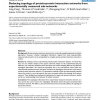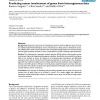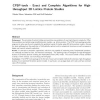13603 search results - page 2694 / 2721 » On the Complexity of Computing Treelength |
BMCBI
2008
13 years 9 months ago
2008
Background: In individually dye-balanced microarray designs, each biological sample is hybridized on two different slides, once with Cy3 and once with Cy5. While this strategy ens...
BMCBI
2007
13 years 9 months ago
2007
Background: Systematic, high-throughput studies of mouse phenotypes have been hampered by the inability to analyze individual animal data from a multitude of sources in an integra...
BMCBI
2008
13 years 9 months ago
2008
Background: Protein-protein interaction networks are commonly sampled using yeast two hybrid approaches. However, whether topological information reaped from these experimentallym...
BMCBI
2008
13 years 9 months ago
2008
Background: Systematic approaches for identifying proteins involved in different types of cancer are needed. Experimental techniques such as microarrays are being used to characte...
BMCBI
2008
13 years 9 months ago
2008
Background: The principles of protein folding and evolution pose problems of very high inherent complexity. Often these problems are tackled using simplified protein models, e.g. ...



